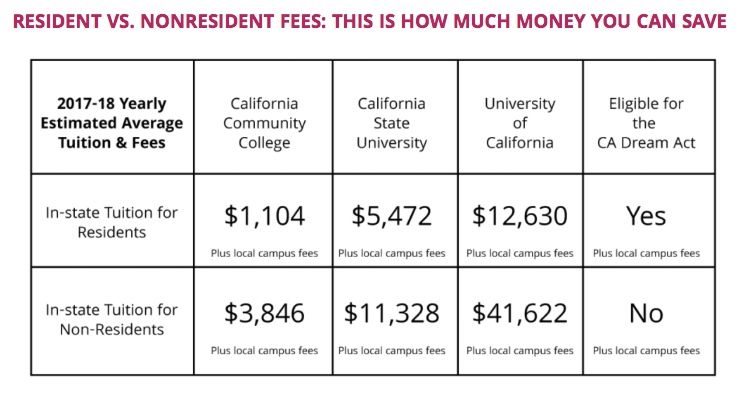How to Pay for College
Getting In-State Tuition
If you are considered a “non-resident” student in California looking to go to college or access higher education, you will pay much higher tuition fees than resident students. In order to pay in-state tuition, the college must determine that you are a California resident for tuition purposes, or that you meet the eligibility to be exempt from non-resident tuition through AB 540/AB 2000/SB 68.
If you are taking English as a Second Language (ESL) courses and/or you are an Undocumented
Student, you may qualify to receive financial assistance to help you pay for your Enrollment
Fees and any Non-Resident tuition. You qualify if you are taking 6 or fewer units
at the San Mateo County Community College District and have been impacted by COVID.

In order to become exempt from your non-resident tuition at a California public college or university, you must complete a “Non-Resident Tuition Exemption” Affidavit form, and return it to Cañada College's Admissions & Records Office, Building 9, First Floor.
Who should fill out the affidavit?
- New incoming students who are individuals without lawful immigration status (undocumented), Deferred Action for Childhood Arrivals (DACA) grantees, students with T or U nonimmigrant status, TPS, U.S. Citizens, Lawful Permanent Residents or other lawfully residing students who are classified as non-residents and meet the eligibility criteria for AB 540, AB 2000 or SB 68.
Why should I fill out an affidavit?
- If you are not classified as a state resident, you will be charged non-resident fees until your af davit and necessary documentation are submitted and processed at the school you plan to attend. Additionally, you will not be eligible to receive your California Dream Act nancial aid until your af davit is processed.
What documentation do I have to submit?
- There are two types of documentation you may be required to submit with the affidavit:
- an official copy of your transcripts from a CA High School or the equivalent (GED), a California Community College (credit or non-credit), an Adult School, or a combination of these transcripts.
- proof that you have or will have graduated with a high school diploma or the equivalent (GED or CHSPE); an Associate’s Degree from a California Community College; or proof that you will have completed the minimum requirements for transfer to a CSU or UC. If you have three years of high school coursework, and attended a combination of three years at CA elementary & secondary schools, you may also be required to submit your transcripts from these schools.
When should I submit my affidavit?
- You should submit your affidavit prior to the deadline listed to the Cañada College Admissions & Records Office, Building 9, First Floor. This is usually sometime after you receive your acceptance letter and prior to your new student orientation. Continuing students should not be required to submit a new affidavit, once it’s been approved, unless they have not attended classes for a full year and need to reapply to the school.
Where should I submit my affidavit?
- You must submit your affidavit to the Cañada College Admissions & Records Office, Building 9, First Floor. Once you submit it, you should follow-up within the next 2 weeks to BE SURE that the College received all the necessary paperwork.
How do I complete the affidavit?
- Fill out your full name, student ID number, address, email, and schools attended,
including dates and length of time. You will also be required to attest that you meet
the eligibility criteria. You must check the box that pertains to you and sign the
form.
- Students with T or U non-immigrant or refugee status should consult with their school before completing the af davit. AB 1899 allows individuals who have been granted T or U status to be considered for in-state tuition eligibility without waiting a year, if they meet the criteria described above. Under AB 343, refugees, T and U visa holders may also be eligible to pay in-state rates immediately, under another exception for these students, if they settled originally in California.
- Students who do NOT have a current nonimmigrant status, including students who are undocumented, DACA recipients, have TPS, are U.S. Citizens, Lawful Permanent Residents, and other lawfully residing immigrants should check the SECOND box.
- Students who have been admitted to the U.S. on a temporary nonimmigrant visa (with the exception of T & U Visas holders) are not eligible to apply for the nonresident tuition exemption.
Assembly Bill 540 is a law that was passed in 2001 by the California legislature. This law is written for students who are undocumented or a U.S. Citizen/Permanent Resident who went to High School in California. If students meet specific requirements, including attending a California public institution of higher education, they are able to pay ‘resident fees’ instead of ‘non-resident fees.’
SB 68 expands AB 540 to enable students to count years spent at a California Community College and Adult School towards AB 540 eligibility. Additionally, the bill will allow the completion of an Associate’s Degree or satisfaction of the minimum requirements to transfer to the University of California (UC) or California State University (CSU) to meet the degree or unit requirements. These new eligibility criteria expand possibilities for students educated in CA to qualify for in-state tuition and state-based financial aid at CCCs, CSUs, and UCs.
- * Must file a “Non-Resident Tuition Exemption” Affidavit form with the school. In the case of students without legal immigration status, they must state that they have filed or will file an application to legalize their immigration status as soon as they are eligible to do so. Download the form submit a completed copy to Admissions and Records (Building 9, 1st floor).
Recursos en Español
- Información General AB 540: Un documento que proveé información en general sobre el acceso a la educación universitaria en California para estudiantes sin documentación legal de estatus migratorio.
- Guia de Apoyo Para Estudiantes AB 540
- Mapa de el California Dream Act: Pasos Para Aplicar con Éxito
AB 540/AB 2000/SB 68 Guidelines for Eligibility
-
Satisfaction of either of the following:
-
High school attendance in California for three or more years, OR
-
Attainment of credits earned in California from a California high school equivalent to three or more years of full-time high school coursework and a total of three or more years of attendance in California elementary schools, California secondary schools, or a combination of those schools. OR
-
Attainment of credits earned at a California adult school, OR
-
Credits earned at a California Community College, OR
-
A combination of the schools listed above
-
Graduated or will graduate from a California high school, OR
-
Attainment of General Education Development (GED), High School Equivalency Test (HiSET), Test Assessing Secondary Completion (TASC), OR
-
Attainment of an associate degree from a California Community College, OR
-
Fulfillment of minimum transfer requirements from a California Community College to a University of California or California State University, AND
-
Will register or enroll in an accredited and qualifying California college or university, AND
-
If applicable, complete(d) an affidavit to legalize immigration status as soon as you are eligible, AND
-
Do not hold a valid non-immigrant visa (F, J, H, L, A, B, C, D, E, etc.)*
Undocumented students who are working to meet AB 540 eligibility and are taking classes in the San Mateo Community College District are able to apply for the 6 or Fewer units Non-Resident Tuition Fee Waiver. This waiver allows students enrolled in 6 or fewer units to reduce the cost of their classes.
The form can be found in the Admissions and Records page and additional information can be found in the following FAQs:
Also, not all AB 540 students are undocumented. Most are legal residents. AB540 forms are worded in a way so as to protect undocumented students from having to declare their status (they are grouped with US citizens and permanent residents). The affidavit says “IF” they are an “alien without lawful immigration status,” then they will pursue a means to change their immigration status when it becomes available.
Check if you qualify for in-state tuition using this tool from Immigrants Rising:
California In-State Tuition Tool
Financial Aid Assistance : CA Dream Act
The California Dream Act (unrelated to DACA) allows some undocumented students to apply for and receive state-based financial aid and institutional scholarships. Passing the California Dream Act symbolize a milestone victory for undocumented students and allies in California who organized and advocated for increased access to college. This represents a critical investment in undocumented students and in the future of California
The types of aid included in the CA Dream Act are:
Cal Grants, UC Grants, State University Grants, California College Promise Grant and EOP or EOPS grants. It also includes the Middle Class Scholarships and school-specific scholarships. The CA Dream Act can also give you access to Dreams Loans at the CSU or UC, even if you are undocumented.
WHO CAN APPLY FOR THE CALIFORNIA DREAM ACT?
Undocumented Students must meet the eligibility criteria for AB 540, AB 2000, SB 68 or U-Visa holders to apply for and receive California state financial aid. The California Dream Act allows students to receive state and institutional grants if they meet income guidelines, apply by the priority deadlines, and complete all necessary paperwork on-time.
STEPS TO APPLY
PHASE 1: APPLY FOR THE CA DREAM ACT. OCTOBER 1 – MARCH 2
1. Download and Review CA Dream Act Application Checklist
2. Click here to start your CA Dream Act application
PHASE 2: APPLY FOR THE CAL GRANT. OCTOBER 1 – MARCH 2
1. Download Cal Grant Checklist
2. Start your Cal Grant Application
PHASE 3: CLAIM YOUR FINANCIAL AID. MARCH – MAY
Read Verifying Income for the CA Dream Act Application
After you submit your CA Dream Act application, a percentage of students will be required
to complete income verification. You must answer all questions, which usually include
household size, assets, information for tax filers and non-tax filers as well as specific
requirements for dependent or independent students.
PHASE 4: USE YOUR FINANCIAL AID. MAY – SEPTEMBER
Read Selective Service and the California Dream Act
Men who are between the age of 18 and 25 years old, even undocumented individuals,
must register for the selective service so your CA Dream Act aid is not put on hold.
Register early and show proof of registration to your school to ensure you receive
state financial aid.
Scholarships
Cañada College Scholarship Information
Immigrants Rising Undergraduate Scholarship List
